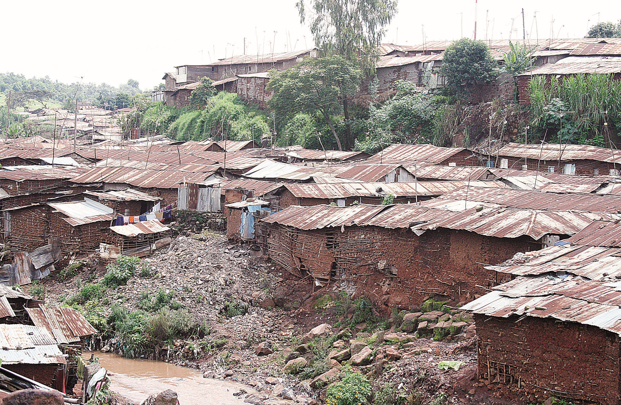Sting of poverty headache for many

The world faces a harsh reality that despite decades of progress, ending extreme poverty across the globe by 2030 is out of reach, economic experts warn.
Reports now indicate that the lasting effects of the COVID-19 pandemic, crushing debt burdens, and rising fragility and conflict have stalled the pace of reducing global poverty.
Devastating climate shocks and extreme weather have further exacerbated the situation, and they threaten to slow or reverse progress even further.
According to World Bank data, about 700 million people, an equivalent of 8.5 per cent of the global population—live in extreme poverty on less than Sh300 a day.
World Bank stated that poverty goes beyond a lack of income, to include insufficient access to education, health, electricity, and other basic services such as safe drinking water or sanitation.
“As of 2024, over one-third of people in countries eligible for support from the World Bank’s International Development Association (IDA) and more than half of those in Sub-Saharan Africa are experiencing multidimensional poverty, highlighting how persistent development challenges remain.
Drastic action
Warning that without drastic action, the global finance lender said it could take decades to eradicate extreme poverty and more than a century to eliminate poverty as it is defined for nearly half of the world.
The worst-hit population is estimated to be a total of 3.5 billion people living in middle-income countries, which are home to three-quarters of the world’s population.
In August last year, the Kenya National Bureau of Statistics (KNBS) reported that the overall poverty rate increased slightly from 37.3 per cent in 2021 to 39.8 per cent in 2022, indicating that 20.2 million people lived below the absolute poverty line.
“The overall poverty incidence was consistently higher in rural areas compared to urban areas. The seven counties with the highest overall poverty rates were Turkana (82.7 per cent), Mandera (72.9 per cent), Samburu (71.9 per cent), Garissa (67.8 per cent), Tana River (66.7 per cent), Marsabit (66.1 per cent) and Wajir (64.7 per cent). In 2022 the counties with the highest number of poor persons were Bungoma (4.4 per cent of the total number of the poor), Nakuru (4.3 per cent), Turkana (4.1 per cent), Nairobi City (3.8 per cent) and Kakamega (3.8 per cent),” KNBS data showed.
The statistics also revealed that absolute poverty lines for rural areas rose sharply from Sh3,252 per month in 2019 to Sh4,358 per month in 2022.
On the other hand, in urban areas, the overall poverty lines also increased from Sh5,995 per month in 2019 to Sh8,006 per month in 2022.
In Kenya and other countries in Sub-Saharan Africa (SSA) World Bank has projected economic growth to an average of 4.2 per cent in 2025-26 due to improvements in the outlook for industrial-commodity-exporting countries, including the region’s largest economies.
However, the agency warned that high government debt and elevated interest rates have narrowed fiscal space, prompting fiscal consolidation efforts in many countries, while financing needs remain high.
“Despite the projected pickup in growth, per capita income gains will remain inadequate to make significant progress in reducing extreme poverty in the region. Risks to the outlook remain tilted to the downside,” World Bank reported.
Among the risks that the bank highlighted include weaker global growth due to heightened uncertainty and the potential for adverse changes in trade policies, a sharper-than-expected slowdown in China, increased regional and global instability like conflicts in Sudan and the Middle East which could drive up energy and food price inflation in the region.
Other foreseeable perils that would affect economies negatively were listed as increased risk of governments’ distress amid a possibility of higher-for-longer global interest rates and greater frequency and intensity of adverse weather events.
In an estimated 103 countries, that make up 86 per cent of the global population, about 1.2 billion people are exposed to at least one climate-related hazard.
“In Sub-Saharan Africa, around 40 per cent of the population is exposed to climate shocks, and almost all of this population is considered at high risk,” World Bank said in the 2025 Global Economic Prospects.
Climatic risks
Apart from tackling climatic risks, the World Bank advised global economies to address gender inequality saying it is essential for development.
“It is key to unlocking economic productivity, reducing poverty, deepening social cohesion, and enhancing the well-being and prosperity of current and future generations,” the agency stated.
It added: “Yet women continue to face barriers to achieving their full potential. In countries at all income levels, fewer women participate in the labour force than men. To make matters worse, the crises afflicting countries today often have disproportionate negative effects on women, girls, sexual and gender minorities, and other marginalized groups.”
Debt sustainability
Globally, World Bank said female labour force participation has remained relatively stagnant over the past three decades and significantly lower than that of males, except in high-income countries. Moving to 2030, the Bretton Wood institution pledged that it will support governments in ensuring that millions more women gain better access to broadband internet, essential services, banking, education, job opportunities, social protection, and capital.
The aid agency also reported in the prospects that all the developing countries had their debt burdens sharply increased following the Covid-19 pandemic further increasing the rate of poverty among citizens.
Additionally, a surge in global interest rates has made it harder for many to regain their footing ever since the outbreak of the ravaging virus.
“At the end of 2023, the total external debt owed by low- and middle-income countries stood at a record $8.8 trillion, an 8 per cent increase from 2020. Interest payments for developing countries surged by nearly a third to $406 billion, leaving countries with less funds to invest in critical areas such as health, education, and the environment,” the Bank stated.
To address the debt crisis in developing countries, the global lender assessed their debt sustainability to bolster their debt transparency and management capacity.















